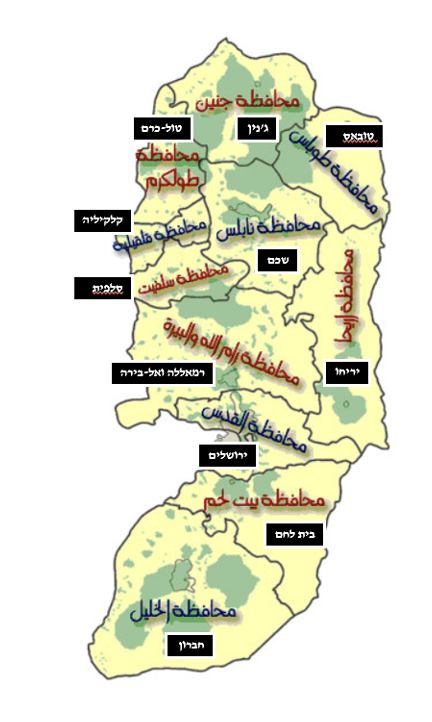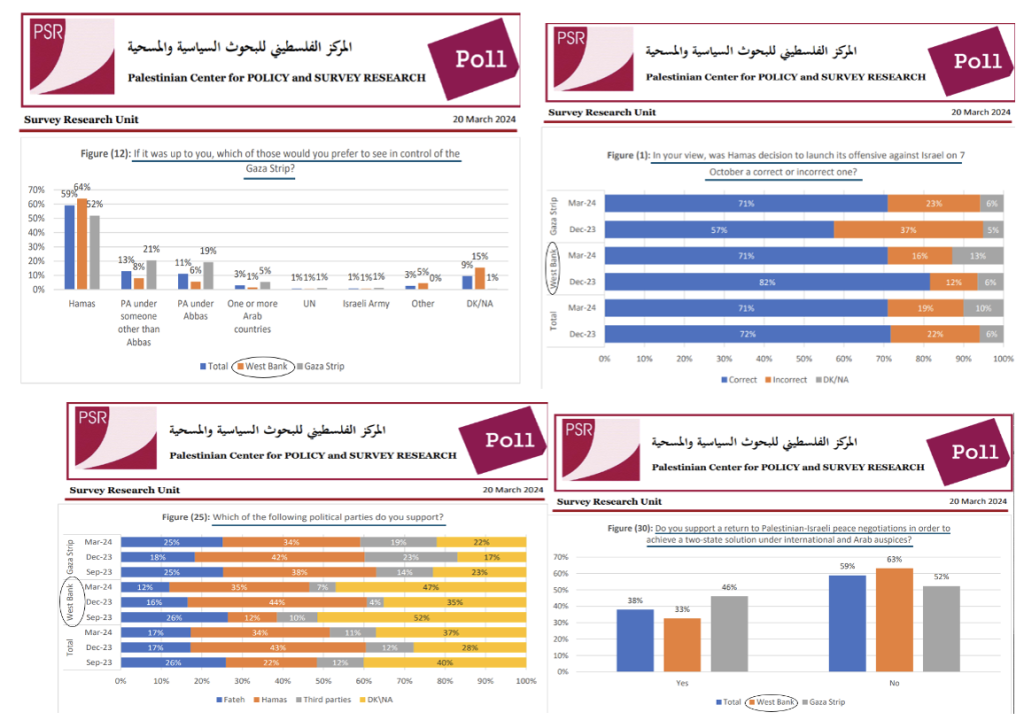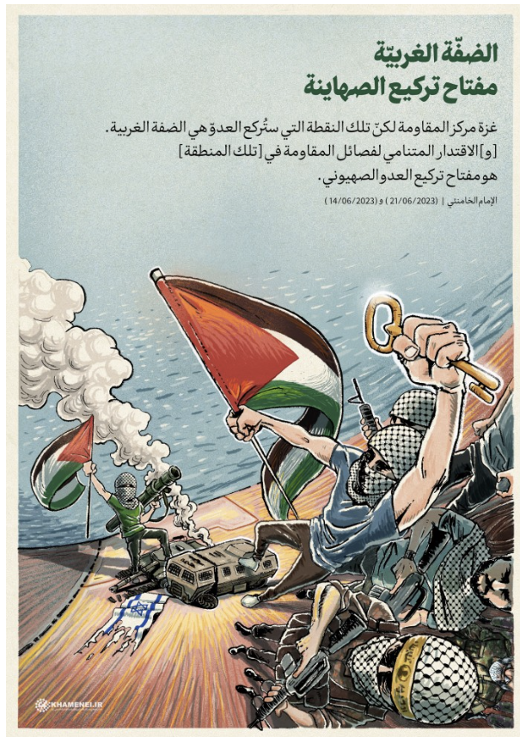Key Trends: The Escalating Security Situation in the West Bank
Abstract
The West Bank holds strategic importance for Israel, facing growing unrest due to the weakening Palestinian Authority (PA), economic decline, and incitement from militant groups. This situation has escalated tensions, motivating young Palestinians and PA security members to confront Israeli Defense Forces (IDF). This trend risks sparking a third intifada, threatening the stability of both the PA and Israeli cities, and requiring additional IDF and Shin Bet resources. Continuous counter-terrorism operations, enhanced security coordination with the PA, and comprehensive PA reforms are suggested to curb this escalation.
This report outlines the current security situation in Judea and Samaria, the demographics of the Palestinian population, and the significant rise in support for militant groups. It also highlights the efforts of various actors, including local organizations, Palestinian militant groups, and external supporters, to ignite the West Bank, alongside the IDF’s counter-terrorism efforts and the PA’s struggle to maintain order. The report concludes with the need for continued counter-terrorism activities and political processes to address the rising terror in the West Bank.
The following article is based on a think tank which its Members are: Dr. Michael Barak, Miri Eisin, Dr. Eitan Azani, Oz Noy, Shalom Ben Hanan, Moshe Levi, Ezra Saar.
Introduction
The West Bank holds significant strategic importance for the State of Israel in many respects. The weakness of the Palestinian Authority (PA), the growing unrest in the West Bank due to the deteriorating economic situation, Hamas incitement, the IDF’s campaign to eradicate Hamas control in Gaza, and friction with settlers significantly increase the motivation of young people in the West Bank to confront IDF forces. This situation also encourages members of the PA’s security mechanisms to join the cycle of terror. This trend of escalation might spread to other West Bank cities. It could potentially lead to the outbreak of a third intifada, different from its predecessors, which would threaten both the stability of the PA and Israeli cities. Forming another front would draw additional IDF and Shin Bet forces, already needed to handle other combat arenas. Continuous Israeli counter-terrorism operations in the West Bank, strengthening security coordination with the PA, initiating the political process, and conducting a comprehensive reform in the PA might curb this trend.
This document seeks to provide a status report on the security situation in Judea and Samaria based on primary and secondary Arabic materials and insights from the think tank members at the International Institute for Counter-Terrorism (ICT) to optimally prepare for dealing with the existing threats in this region.
The West Bank comprises 11 districts: Jenin, Nablus, Hebron, Ramallah and al-Bireh, Bethlehem, Jericho, Tubas, Jerusalem, Tulkarm, Salfit, and Qalqilya. According to the Palestinian Central Bureau of Statistics in Ramallah, the Palestinian society in the West Bank numbered approximately 3,257,000 people in 2023 (98% Sunni Muslims, about 1.37% Christians of various denominations). Their findings indicate that most of the Palestinian population in the West Bank is young, with a growth rate of 2.1%. 35.2% of the Palestinian population in the West Bank are children (under 14), about 28.1% are teenagers and young adults (aged 15 to 29), and about 6.3% are over 60.[1] This is significant since Palestinian terrorist organizations, led by Hamas, invest considerable efforts in recruiting a young audience in the West Bank through various means, including social media.

Support Rate for Hamas Among West Bank Residents
Notably, since the October 7 massacre, there has been an increase in the support rate for Hamas among West Bank residents, alongside a significant drop in support for the PA and its institutions. According to a public opinion poll conducted by the Palestinian PSR Institute in March 2024, 71% of West Bank residents justified Hamas’s massacre in the Gaza periphery settlements; 64% of West Bank residents expressed support for Hamas’s rise to power in Gaza; 35% support Hamas compared to 12% who support Fatah, with 47% having no particular political preference; 63% also opposed the renewal of peace negotiations between Israel and the Palestinians and the idea of a two-state solution under international and Arab sponsorship.[3]

However, in later public opinion surveys by the same Palestinian polling institute, there was a trend of declining support for Hamas among West Bank residents, likely due to the IDF’s success in advancing in Gaza and the increasing distress of Gazans in light of Hamas’s entrenchment in its positions. For example, a public opinion poll from April 2024 indicated only 18% support for Hamas in the West Bank (see diagram).[4]

Efforts to Ignite the West Bank
According to the ICT think tank, three leading players are identified as investing efforts in recruiting West Bank residents for terrorist activities to ignite the area: resident organizations without organizational affiliation; Palestinian terrorist organizations, especially Islamic Jihad and Hamas; and Iran and Hezbollah.
In Hamas’s leadership view, the West Bank constitutes Israel’s “soft underbelly,” partly due to its proximity to central Israeli settlements. In April 2021, Yahya Sinwar declared that the West Bank is considered the main battlefield of the Palestinians against Israel and called on West Bank youths to intensify terrorist activities against settlers and drive them out of the area.[5] Saleh al-Arouri, a senior Hamas figure responsible for the West Bank file in the organization (eliminated by Israel after October 7), was prominent in recruiting West Bank residents for confrontation against Israel.[6] Hamas and Islamic Jihad supporters have been running incitement campaigns on social media, calling on West Bank youths to kill Jews, confront IDF forces, and fulfill the duty of jihad against Israel. For example, on May 16, 2024, Hamas published on social media the will of a Hamas member killed in an IDF counter-terrorism operation, calling on West Bank residents to join the armed struggle against Israel (see picture).[7]

Iran is also carrying out a significant effort to ignite the West Bank. In August 2022, Hossein Salami, a senior commander in the Iranian Revolutionary Guards, emphasized that the process of arming the Palestinians in the West Bank is underway.[8] Ali Khamenei, the leader of Iran, called a decade ago to arm the West Bank and, in other speeches, clarified that Israel’s power should be challenged through the Gaza Strip and the West Bank (see picture below).[9] In July 2023, Ziyad al-Nakhalah (Secretary-General of the PIJ) stated in an interview with Iranian media that his organization is investing efforts in establishing armed groups, arming other Palestinian factions, and imparting knowledge of bomb assembly in the West Bank while coordinating with Iran. According to Ziyad al-Nakhalah, this arming is carried out through weapon smuggling into the West Bank and buying weapons from Israelis.[10] There are also voices of criticism within the Palestinian Authority against Iranian subversion in the West Bank and its efforts to overthrow the Palestinian Authority through support for Hamas and PIJ.[11]

From this perspective, Iran operates to flood the West Bank with weapons and explosives through various smuggling routes across the Middle East, utilizing intelligence agents, militia members, and criminal gangs. These smuggling operations are primarily conducted through Jordan, from where the weapons are transferred to the West Bank via Israeli Bedouins.[13] According to data from the Israel Police in the Judea district, in 2023 alone, 381 weapons were seized in the Judea region, 153 of which were smuggled through the border with Jordan, and 16 smuggling attempts were thwarted by Israeli security forces. In the first half of 2024, approximately 200 weapons were seized.[14] Zaher Jabarin, a senior Hamas official and the successor of Saleh al-Arouri as the leader of the organization in the West Bank, pointed to another source of smuggling. According to him, M16 rifles reach the West Bank after being purchased from IDF soldiers who stole them from military bases.[15]
Signs of Escalating Security in the West Bank
According to Shin Bet data, 2023 was characterized by a significant escalation in the West Bank in all parameters, which worsened since October 7. According to the data, 3,436 terrorist attacks were carried out in Judea and Samaria and the Green Line in 2023. 4,584 Palestinians in Judea and Samaria, 345 Palestinians in East Jerusalem, and 171 Palestinians in the Green Line were arrested for involvement in terrorist activities.[16]From January to May 2024, 120 significant terrorist attacks were carried out, and 470 significant terrorist attacks were thwarted (see graphs below).[17] From January to May 2024, 1,460 terrorists were arrested in Judea and Samaria, and Jerusalem.[18]
The think tank team points out that the source of terrorist activity in the West Bank in recent years has been the refugee camps, especially Nur al-Shams (east of Tulkarm), where the violence rate is estimated at over 70%, with the Islamic Jihad playing a significant role in efforts to ignite the Judea and Samaria area. Since 2022, the PIJ has strengthened its position by adopting a new strategy that involves assisting small groups of local armed men, primarily in the northern West Bank. It should be noted that one of the phenomena that have developed mainly in the refugee camps is the emergence of local “battalions,” which usually include activists from several organizations, including PIJ, Fatah, the Popular Front for the Liberation of Palestine (PFLP), and even Hamas, where organizational affiliation blurs while local affiliation strengthens significantly.
At least nine local militant groups can be identified as associated with and supported by the PIJ, headed by the Jenin Battalion (Katibat Jenin),[19] the Nablus Battalion (Katibat Nablus), and the Tulkarm Battalion (Katibat Tulkarm) – areas where the PIJ had a foothold even before the Second Intifada. Six other groups associated with the PIJ operate with varying intensity in the West Bank: the Tubas Battalion, the Birqin Battalion, the Jericho Battalion, the Jaba Battalion, and the Qabatiya Battalion, where recruitment methods in the northern West Bank are conducted through close ties, friendships, and local identity, while in Hebron, there is a more classic recruitment pattern based on connections between security prisoners and field operatives in the southern West Bank.[20]
The think tank team also emphasized that the PIJ significantly assists other Palestinian factions in the West Bank, such as “Lion’s Den” (Arin al-Aswad). This independent group numbered about 30 people with no organizational affiliation. It was established by a young Palestinian man in Nablus named Muhammad al-Azizi in July 2022, who previously belonged to the “Martyrs of the Al-Aqsa Brigades.” This group brought together young Palestinians frustrated by the impotence of the Palestinian leadership to solve political and economic problems, seeking to rise above political and ideological disputes within the Palestinian leadership and saw fit to confront IDF forces. It seems that this organization ceased operations in April 2024 due to IDF counter-terrorism activities, arrests made by the Palestinian Authority among their ranks, and the integration of some of its members into the Palestinian security mechanisms.[21]
According to team members, the “Al-Aqsa Martyrs’ Brigades,” a prominent Palestinian faction in the West Bank indirectly affiliated with the Fatah movement, also receives assistance from the PIJ – a worrying trend in itself. This faction was founded with the outbreak of the Second Intifada on September 28, 2000, by Yasser Arafat (leader of the Palestinian Authority), who took part in terrorist attacks against Israeli soldiers and civilians. In 2007, Abu Mazen ordered the disbandment of this faction and the integration of its members into the Palestinian Authority mechanisms to adhere to the political track with Israel. In 2021, after Operation Guardian of the Walls, the “Al-Aqsa Martyrs’ Brigades” renewed their activities and took an active part in the confrontation with IDF forces in the West Bank. Its structure is decentralized and consists of several armed groups operating in different areas of the West Bank, including the Askar Battalion, the Amar Battalion, the Tulkarm “Rapid Response” Battalion, the Al-Samu Battalion, and the “Tall al-Fajr Battalion.” Since October 7, the “Al-Aqsa Martyrs’ Brigades” declared an open campaign against Israel throughout the West Bank. Their activities are focused on Jenin and Nablus.[22] It can be noted that in an interview conducted by several members of the “Al-Aqsa Martyrs’ Brigades” in the largest refugee camp in the West Bank, “Balata Camp,” with a reporter from the inter-Arab daily “Asharq al-Awsat,” they revealed why they decided to join this group and renew the armed struggle against Israel. They pointed to their dissatisfaction with the Palestinian Authority’s conduct towards Israel, disappointment with the political process, the IDF’s military activities in the West Bank, and confrontations with settlers.[23]
In the view of the team members, Hamas is also trying to establish itself in the West Bank, but not with much success due to the successful counter-terrorism activities of the IDF, which help reduce the ability of West Bank Arabs to carry out attacks. Between March 2023 and September 2023, Hamas operated in the western part of Jenin under the “Al-Ayyash Battalion.” Between 2022 and April 2023, it operated in Jericho under the “Aqabat Jabr Battalion.” Suleiman Basharat, director of the Palestinian research center “Yabous” in Ramallah, also shares this assessment and claims that Hamas is unable to establish itself in the West Bank due to the successful counter-terrorism activities of the IDF to destroy its infrastructure there.[24] According to the think tank team, IDF activities in the West Bank also managed to prevent recruitment efforts of Israeli Arabs by the residents of the former.
Summary – Current Situation
In conclusion, the think tank members believe that the northern West Bank is undergoing increasing escalation, partly due to the involvement of the Palestinian Islamic Jihad, Hamas, and Iran, which aim to create an additional front against Israel. The Palestinian Authority’s policy of containment and avoidance of friction with Palestinian factions and its failed attempts to persuade armed groups to lay down their weapons (except for the “Lion’s Den” group) are expressions of the Palestinian Authority’s weakness in the West Bank. Even when the Palestinian Authority carries out actual arrests of terrorist operatives, the indictments against them are weak and result in their release. Overall, the cooperation between the IDF and the Palestinian Authority has a marginal impact on the situation. This raises the question of who should enforce order and security in the West Bank: an improved and significantly reformed Palestinian Authority, a new Palestinian power, Israel, or an international force? For now, it seems that only the continuation of counter-terrorism activities by the IDF and measures to prevent arms smuggling into the West Bank by Israeli security bodies can help curb the rising terrorism in the West Bank, alongside the renewal of the political process between Israel and the Palestinian Authority, which can provide hope and a political horizon.
The think tank believes it is crucial to foster the creation of a tolerant ideological climate to ensure long-term and stable peace with the Palestinians. This can be achieved through reforming the Palestinian Authority’s education system by removing negative references to Israel from its textbooks. The think tank further believes that Gulf states, such as the United Arab Emirates, can contribute their knowledge acquired over the years in leading a de-radicalization program for young Palestinians in the West Bank and Gaza and in fostering a moderate ideological climate. The Israeli academia has a vital role in nurturing the ties between the peoples.
[1] The head of the Palestinian Central Bureau of Statistics reviews the situation of Palestinians at the end of 2023, on the eve of the beginning of the year 2024 (in Arabic), the Palestinian Central Bureau of Statistics mechanism. 31.12.2023. https://www.pcbs.gov.ps/postar.aspx?lang=ar&ItemID=4675
[2] WAFA Agency. https://info.wafa.ps/userfiles/image/WestBank.jpg
[3] “Public Opinion Poll No (91)”, Palestinian Center for Policy and Survey Research (PSR), March 20, 2024.
[4] “Arab Barometer: Palestinian Perception of Governance (Report III)”, Palestinian Center for Policy and Survey Research (PSR), April 22, 2024.
https://pcpsr.org/sites/default/files/AB8%20Palestine%20Report%203%20English%20version%2022April%202024.pdf
[5] Al-Sinwar: “The West Bank is the main battlefield” (in Arabic), Palestine – Al Jazeera. 2.5.2022. https://www.facebook.com/AJA.Palestine/videos/698413387947458/
[6] Sapir Lipkin, “The Number 2 in Hamas, the Architect of Terror in the West Bank | This is Saleh Al-Arouri who was killed in Beirut,” N12, 2.1.2024. https://www.mako.co.il/news-military/2024_q1/Article-0263109080bcc81027.htm
[7] Telegram “The Will of the Martyr Adnan Samara” (in Arabic), (affiliated with Hamas), 16.5.2024.
[8] Al-Salami: “The process of arming the West Bank is currently underway, just as Gaza was armed” (in Arabic), Al-Mayadeen, 21.8.2022. https://www.almayadeen.net/news/politics/سلامي:-عملية-تسليح-الضفة-تجري-حاليا-مثلما-تسلحت-غزة
[9] “Mr. Ali Khamenei: Arming the Palestinian resistance in Gaza… and also the West Bank” (in Arabic), Al-Mayadeen, 24.7.2014. https://www.almayadeen.net/news/السيد-علي-خامنئي–تسليح-المقاومة-الفلسطينية-في-غزة–والضفة-أ
[10] Al-Nakhalah: “We are working to form combat brigades in the West Bank and all Palestinian cities” (in Arabic), Mehr News, 2.7.2023. https://ar.mehrnews.com/news/1934576/النخالة-نعمل-على-تشكيل-كتائب-مقاتلة-في-الضفة-الغربية-وكافة-المدن
[11] “The Palestinian Authority and the Fatah movement against Iran: Undermining the Palestinian Authority and Jordanian rule through its proxies Hamas, Palestinian Islamic Jihad, and the Muslim Brotherhood,” MEMRI, 16.5.2024. https://www.memri.org/webaxy/item?6128
[12] Imam Khamenei, “The West Bank is the key to defeating the enemy” (in Arabic, no date), Khamenei. https://arabic.khamenei.ir/news/7486
[13] Haaretz, “Iran smuggles weapons to Palestinians in the West Bank through secret routes across the Middle East,” 9.4.2024. https://www.haaretz.co.il/news/politics/2024-04-09/ty-article/0000018e-c390-dc93-adce-eff06daa0000
[14] Hanan Grayevand, “We must not lose: The battle against weapon smuggling from Jordan,” Israel Hayom, 7.6.2024. https://www.israelhayom.co.il/news/defense/article/15878554
[15] Zaher Jabarin to Al-Araby Al-Jadeed: “The resistance can manage a war of attrition in Gaza” (in Arabic), Al-Araby Al-Jadeed, 14.5.24. https://www.alaraby.co.uk/politics/زاهر-جبارين-لـالعربي-الجديد-المقاومة-قادرة-على-إدارة-حرب-استنزاف
[16] “Annual Summary,” Israel Security Agency, 1.1.2024. https://shabak.gov.il/media/zpledoyg/2023-דוח-חיצוני-סיכום-שנה.pdf
[17] “Monthly Reports,” Israel Security Agency, January – May 2024. For example, May 2024 report: https://shabak.gov.il/media/alueae1q/דוח-2024-מאי-עברית.pdf
[18] Ibid.
[19] “The Jenin Battalion began operating in the Jenin refugee camp in May 2021, led by Jamil al-Amouri (a former member of the PIJ military wing, Saraya al-Quds, who was eliminated by Israel). It managed to recruit dozens of young people based on local connections. In an interview with the inter-Arab daily Asharq al-Awsat, the thirty-year-old leader of the Jenin Battalion said he decided to join armed activities against IDF forces due to the loss of hope for a better future, the continued Israeli aggression, and the understanding that Israel has no intention of implementing the two-state solution.” Baha Malhem, “A new generation of armed men in the West Bank warns of an imminent explosion” (in Arabic), Asharq al-Awsat, 29.5.2024. https://aawsat.com/arabic-and-international/قضايا-في-العمق/تحقيقات-جديد-جيل-من-المسلحين-في-الضفة-الغربية-ينذر-بانفجار-قريب/4352526
[20] According to the ICT Research Fellows Forum.
[21] “Washington imposed sanctions on it.. What is the Arin al-Aswad group?” (in Arabic), Al-Hurra, 7.6.2024. https://www.alhurra.com/arabic-and-international/2024/06/07/فرضت-واشنطن-عليها-عقوبات-ما-هي-مجموعة-عرين-الأسود؟
[22] “President Arafat had credit for the establishment, and after sixteen years of its dissolution.. what do you want to know about the Al-Aqsa Martyrs’ Brigades?” Arabic Post, 18.12.2023. https://arabicpost.net/منوعات/18/12/2023/كتائب-شهداء-الأقصى/
[23] Baha Malhem, “A new generation of armed men in the West Bank warns of an imminent explosion” (in Arabic), Asharq Al-Awsat, 29.5.2024.
[24] Khalil Musa, “Israel is chasing Hamas in the West Bank,” Independent Arabia, 9.5.2024. https://www.independentarabia.com/node/576266/سياسة/تقارير/إسرائيل-تلاحق-حماس-في-الضفة-الغربية






